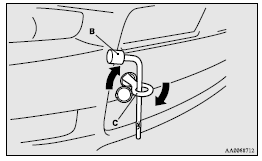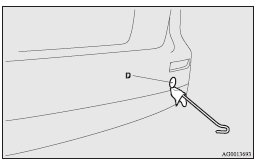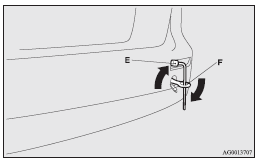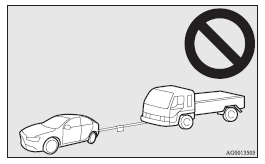
Mitsubishi Lancer Owners Manual
Emergency towingFor emergencies / Towing / Emergency towing
If towing service is not available in an emergency, your vehicle may be temporarily towed by a rope secured to the towing hook.
If your vehicle is to be towed by another vehicle or if your vehicle tows another vehicle, pay careful attention to the following points:
If your vehicle is to be towed by another vehicle
1. Take out the towing hook, wheel nut wrench and jack bar. (Refer to “Tools and jack”.)
2. Cover the tip of the jack bar with a cloth, then use it to remove the cover (A) that is located on the front bumper.

3. Use the wheel nut wrench (B) to securely mount the towing hook (C).

4. Secure the tow rope to the front towing hook.
![]()
► Do not tow the vehicle with the rope at an excessive diagonal angle.
![]() Note
Note
► To avoid deforming or otherwise damaging the vehicle body when hooking the
rope onto the towing hook, observe the following instructions: • Mount the towing
hook securely.
• Do not attach the rope to any part of the vehicle other than the towing hook.
• Ensure that the tow rope is taut when the towing vehicle moves away.
5. Keep the engine running.
If the engine is not running, turn the ignition switch to the “ACC” or “ON” position (M/T) or “ON” position (CVT) to unlock the steering wheel.
![]() Note
Note
► For vehicles equipped with the Auto Stop & Go (AS&G) system, press the “Auto Stop & Go (AS&G) OFF” switch to deactivate the Auto Stop & Go (AS&G) system before stopping the vehicle. Refer to “To deactivate”.
![]()
► When the engine is not running, the brake booster and power steering system do not operate. This means higher brake depression force and higher steering effort are required. Therefore, vehicle operation is very difficult.
![]()
► On vehicles with Twin Clutch SST, have the vehicle transported by a tow
truck with all wheels raised off the ground if the engine does not start. If the
vehicle is towed without starting the engine, the Twin Clutch SST may be damaged
because the fluid will not reach all parts of the transmission. Refer to “If your
vehicle needs to be towed”.
► Do not leave the key in the “LOCK” position.
The steering wheel will lock, causing loss of control.
6. Place the gearshift lever (M/T) in the “Neutral” position, or the selector
lever (CVT) or gearshift lever (Twin Clutch SST) in the “N” (NEUTRAL) position.
7. Turn on the hazard warning lamps if required by law. (Follow the local driving
laws and regulations.)
8. During towing make sure that close contact is maintained between the drivers
of both vehicles, and that the vehicles travel at low speed.
![]()
► The person in the vehicle being towed must pay attention to the brake lamps
of the towing vehicle and make sure the rope never becomes slack.
► Avoid sudden braking, sudden acceleration and sharp turning; such operation could
cause damage to the towing hooks or the tow rope.
People in the vicinity could be injured as a result.
► When towing or being towed down a long slope, the brakes may overheat reducing
the effectiveness. In this situation, have your vehicle transported by a tow truck.
► When the vehicle with CVT or Twin Clutch SST is to be towed by another vehicle
with all wheels on the ground, make sure that the towing speed and distance given
below are never exceeded, in order to avoid damage to the transmission.
Towing speed: 40 km/h (25 mph)
Towing distance: 40 km (25 miles)
For the towing speed and the towing distance, follow the local driving laws and
regulations.
9. When finished towing, remove the towing hook, and stow it in the specified location. Refer to “Tools and jack”.
When installing the cover, align the hook with the cut out area on the vehicle, and firmly insert.
If your vehicle tows another vehicle
1. Take out the towing hook, wheel nut wrench and jack bar. Refer to “Tools and jack”.
2. Cover the tip of the jack bar with a cloth, then use it to remove the cover (D) that is located on the rear bumper.

3. Use the wheel nut wrench (E) to firmly attach the towing hook (F).

4. Always attach the tow rope to the towing hook. Otherwise, the instructions are the same as for “When being towed by another vehicle”.
5. When finished towing, remove the towing hook, and stow it in the specified location.
Refer to “Tools and jack”.
When installing the cover, align the hook with the cut out area on the vehicle, and firmly insert.
![]() Note
Note
► Do not tow a vehicle heavier than your own vehicle.







